
|
Vehicles Wednesday November 19 2003 There and back again (a short Canadian's tale) 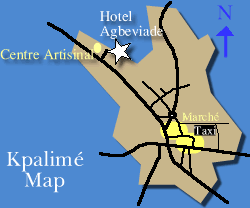 Finding
your way around various cities and villages is its own type of challenge
for a stranger. This is due to the fact that there are no street names
or house number, only landmarks that you would only recognize if you
have lived there your whole life. There is no such thing as a map
of Kpalimé. I had to create one myself for the Hotel
Agbeviade site. I think this excerpt from Kathleen
Fodrek's journal describes it well: Finding
your way around various cities and villages is its own type of challenge
for a stranger. This is due to the fact that there are no street names
or house number, only landmarks that you would only recognize if you
have lived there your whole life. There is no such thing as a map
of Kpalimé. I had to create one myself for the Hotel
Agbeviade site. I think this excerpt from Kathleen
Fodrek's journal describes it well:
In addition to this, is the fact that a taxi-driver may say that he knows where he's going, but you definitely can't take his word for it. They will often drive around aimlessly, even though they say they know where they are going, and you have to point out each turn that needs to be made. back to topThurs Oct
16 The moto-taxi was born in the adjacent country of Benin. It came into being about 10 years ago as a result of excess poverty. There was no work, motorbikes are cheap, and people had no money for cars, so the fares for taking a moto taxi are super-cheap. 100 francs (about a quarter) will get you just about anywhere in Kpalimé. Let me tell you, this is a pretty compelling price as opposed to walking for half an hour in blistering heat, knowing that you will have to spend another half hour upon arrival to wash your ridulously sweaty clothes as a result of that walk! There are five stages to taking a moto-taxi
Step 1 – NOT getting a moto-taxi
ride Step 2 – Getting a moto-taxi ride One of the keys in getting a moto-taxi, is to look for ones that are beat up ones, that way you know that they can't go to fast. This bring us to the next step… Step
3 – Riding the moto-taxi Being on asphalt roads can be kind of spooky, because the moto can reach fast enough speeds, and the surface is hard enough that you know some serious damage could be done if you fell. The real fun though is on the side roads. The side roads are made of dirt, and are best described as “undulated”. Because of their extreme non-flatness, the driver is forced to go slowly, while also manoeuvring around many obstacles and people. This is rather fun because the driver is going all over the place, and slowly enough that you could fall off without any problem. Every now and then something out of the ordinary may happen, like a car might be following, give a honk telling the moto-taxi driver to get out of the middle of the road, which he reluctantly does eventually and the car passes. What is interesting about this is that the moto-taxi driver will then proceed to discuss this event while driver, sometimes becoming rather angry… I just smile and nod. Step 4 – Directing the moto-taxi Step 5 – Disembarking and paying
for the Moto-Taxi And there you have it, the moto-taxi! back to topMonday Oct 27,
2003
While steps 4 and 5 don’t change (much) at night, steps 1-3 do. Step 1, not getting a moto-taxi ride at night, is much easier than not getting one during the day. The is primarily due to the fact that there are no streetlights (well, maybe 2) in Kpalimé, and my skin looks as black as the next person’s in pitch blackness. So the automatic “Yovo want’s a ride” honk doesn’t come into effect. Step 2, Getting a moto-taxi ride at night, is much more difficult for the same reasons that step one is easier. The technique then, is to stand under one (of the two) street lights in Kpalimé, so that my white skin becomes quite obvious, at which point the first available moto-taxi will stop. At times, even moto-taxi’s that have a fare will yell “j’arrive!” as they drive by, meaning “I’m coming” as soon as they drop of their fare. It is these over-ambitous drivers that cause a possible extra night-time wrinkle in step 5… Step 3, riding the moto-taxi at night is where the biggest difference is found. All the details are in the lights. The headlight on a moto-taxi at night is about as strong as my lemon powered light bulb in my 6 grade science fair project. As such, it is important to specify “doucement”, or “go gently” when travelling at night. Of course, they don’t usually crash at night because I guess they must have some kind of infrared night superhuman cat-like night-vision that I just don’t posess. I have confidence in that night-vision of course, but I they honour my “doucement” to humour the Yovo. What’s even better about the night light, is that whenever the moto-taxi speeds up, slows down, shifts gears, or turns a corner, the light gets even dimmer, and sometimes goes out for a moment (which doesn’t faze their cat-like vision of course)! Step 4, giving directions, doesn’t change, except that night drivers are usually chattier, and may forget your directions by the time you finish your en-route discussion. Step 5, the payment, doesn’t change, usually, except that some drivers try to pull the ‘ol 50 francs extra at night trick, especially the ambitious ones mentioned in step 2. That’s when I have to pull the old “100 francs c’est tout que j’en a dans mon poche” trick, meaning “100 francs is all I’ve got in my pocket”. More on that when I tackle the subject of bartering… So then I give the driver a Bon-Soir, and he’s off to terrorize his next victim in the night! Saturday December 6 2003 Grandpa Smurf – Where’s E-on? (I don't think you'll find your tail here...) 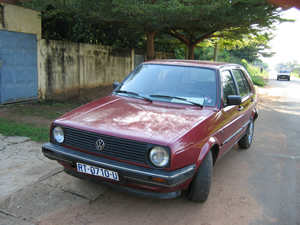 Kpalimé
is a town of moto-taxis, or little scooters. There are not really
many cars, so I am getting to know each of the non-moto vehicles in
town because I see them often. One day, as I was walking down the
street, I saw Grandpa Smurf, which is my friend Ian's car! "What’s
This?!" I said to myself, "Has Ian come to Togo without
telling me? If so, why didn't he let me know he was coming? Maybe
he doesn't know my new e-mail address is tim@berezny.com,
maybe he doesn't realize that I live just down the street from where
he's parked, maybe he doesn't know how to ask for directions to find
me because he's terrible at French..." The questions just kept
pouring through my head. So, Mr.Ian Frey, I know you're here, I have
photo evidence of your car 'Grandpa Smurf' here in Kpalimé
Togo, you can't deny it, show yourself! Kpalimé
is a town of moto-taxis, or little scooters. There are not really
many cars, so I am getting to know each of the non-moto vehicles in
town because I see them often. One day, as I was walking down the
street, I saw Grandpa Smurf, which is my friend Ian's car! "What’s
This?!" I said to myself, "Has Ian come to Togo without
telling me? If so, why didn't he let me know he was coming? Maybe
he doesn't know my new e-mail address is tim@berezny.com,
maybe he doesn't realize that I live just down the street from where
he's parked, maybe he doesn't know how to ask for directions to find
me because he's terrible at French..." The questions just kept
pouring through my head. So, Mr.Ian Frey, I know you're here, I have
photo evidence of your car 'Grandpa Smurf' here in Kpalimé
Togo, you can't deny it, show yourself!
Tuesday December 23 Accidents, a way of life (or a way of death) For the Christmas holidays I left Kpalimé and headed up to Kara. Kara is in north of Togo, and home of the Kabyé (pronounced Cab-Yay) people. President Eyedema is from this area, and has Kabyé roots. As such, he has apparently put some extra money into this town. You wouldn't really know that by looking at it though, except for noticing a few large nice buildings that people aren't quite sure what they are used for, and a very large, unfinished overgrown coliseum type building that looks like allot of money was wasted on it. The drive up to Kara was interesting. The first thing that struck me was the high number of car accidents. Driving through Adéta, which is about 1/2 hour north of Kpalimé, we saw a bicycler try and slip through some cars that he shouldn’t have, then run into the side of a car that was turning (he was okay I think). Shortly after there was a one lane bridge, and we were going to arrive at it way in advance of the oncoming car, but the oncoming car just sped up to beat us to the bridge, and we had to come to a screeching halt. Then there were a number of abandoned cars on the side of the road, as well as truck drivers walking around the outside of their broken down trucks, trying to figure out why it won't run.
Eventually, we came to what looked like a large cargo truck accident. The truck, and possible other vehicles were across the whole road and everything was on fire. Apparently the road had been blocked for a while, because there was another dirt road that had actually been bulldozed around the accident through the adjacent forest. The detour road was only wide enough for one car, so there were civilians (many civilians) on each side of the detour managing the passageway. Of course, they would only let you pass if you coughed up some money. Big accident = big money making opportunity. Strangely enough there were no police or army personnel there to manage it, which I did not understand.
The really sad thing as we were driving up the mountain was the number of broken guard rails where you could tell that cars had just flown over the edge. There were many sections with guard rails, and there would always be at least one section with a hole. Sometime the entire guard rail had been ripped off. There was also debris of vehicles down in the pits off the side of the road that could at times be seen. Once we made it to Kara, we saw two car/moto-taxi accidents. In the second one that we saw there was a moto-taxi entirely underneath a car, but I didn't see any body so I think the driver may have hopped off in time. I realized that this is a way of life here, every time you go in a car you really do put your life on the line (true in Canada also, but not even close to the same extent) Many of the Togolese attribute this to "bad spirits" rather than connecting it with speed and dangerous driving. For the first time since I got here (or ever in my life really) I started to feel very vulnerable, that life was very very fragile. Death is a way of life here. (More on this in another article, as this idea ties in with many other observations). This was a scary revelation, because I am just as vulnerable as any of them. Many travellers don't realize that in Africa, the most dangerous thing to travellers is not malaria or typhoid or bugs that burrow into your spine, but vehicle accidents. I think that this is because the third world is stuck in a place where it has some of the privileges of the developed world, but doesn't have the infrastructure to responsibly use it (i.e. Enforce/educate driving laws, traffic lights and signs, maintain roads, paint dividing lines on the roads, maintain cars so that their doors don't fall off etc...). There also seems to be this wacky idea that if you can afford something expensive, you have to push it as far as it will go. This is best illustrated in the way the Togolese play their music. They will almost ALWAYS have it pumped up as loud as it can go, and sit right in front of the 4 foot speakers playing it. I just don't get it; it's painful to even walk near those places. Any car that is playing music in their radio will also have it pumped up to such levels that you can't hope to have a discussion with anybody in the car. Even in hotel with, the only shows on the television that are playing might be in some language that nobody understands, but the television stays on none-the-less. I think this attitude transfers to driving habits too... "I have power in my car, so now I have to use it to the max". This attitude of course is quite unbalanced, but I think that it is a result of them having very little power over other aspects of their lives, over their finances, their jobs, their success; they have to transfer their need for control somewhere else. All of this makes me feel quite physically vulnerable, and certainly very uneasy about travel, but it is kind of a necessary evil. back to top |

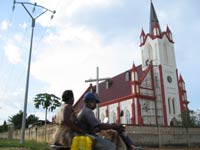 The
moto-taxi is a strange beast indeed. "moto" is French
for motorbike. Thus, a "moto-taxi" is a taxi-motorbike.
They are actually more like fast scooters.
The
moto-taxi is a strange beast indeed. "moto" is French
for motorbike. Thus, a "moto-taxi" is a taxi-motorbike.
They are actually more like fast scooters.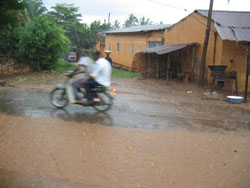
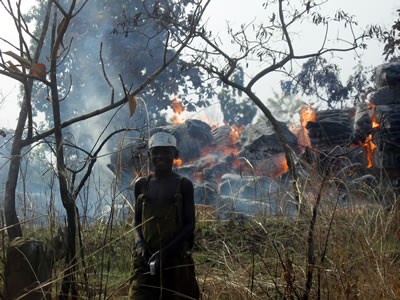
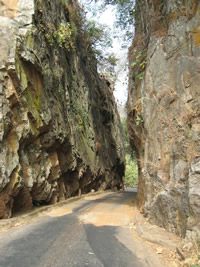 Eventually
we made it to a mountain pass. Much of the road ran along the edge
of a big cliff. We came upon a caravan of trucks, who were probably
not going any faster than 2 km/h, because they were so afraid of
their brakes burning out (It wouldn't surprise me if their standard
to decide when brakes should be replaced is only once they don't
work at all any more).
Eventually
we made it to a mountain pass. Much of the road ran along the edge
of a big cliff. We came upon a caravan of trucks, who were probably
not going any faster than 2 km/h, because they were so afraid of
their brakes burning out (It wouldn't surprise me if their standard
to decide when brakes should be replaced is only once they don't
work at all any more).